Do you want your living room to be an underwater world of peace? Do not look any further! We have put together a list of 30 beautiful, peaceful freshwater fish that will turn your community tank into a magical underwater world.
Fish that live in calm, fresh water are the most important part of any community tank. These calm swimmers not only add bright colors and interesting behaviors, but they also help keep everyone in the aquarium stress-free. A recent poll by the American Pet Products Association found that 11.8 million homes in the U.S. have freshwater fish. This makes fish the third most popular pet, after dogs and cats.
The peaceful pond fish on our carefully chosen list range from the ever-popular neon tetra to the beautiful angelfish. People who are new to aquarium keeping or who have experience with them can both get along with these species because they are relatively peaceful.
Did you know that the kuhli loach and other peaceful pond fish can live up to 10 years in a tank? Because they live so long, you can bond with your water pets and enjoy their company for many years.
When picking calm freshwater fish for your community tank, think about things like
- Size limits for tanks
- Preferences for water parameters
- Schooling behaviors
- Requirements for food
- Getting along with other species
If you choose the right mix of fish from our list, you can create an environment that is both healthy and beautiful to look at. Remember that a well-balanced community tank not only gives its humans stress-relieving benefits but also endless amusement. Studies have shown that looking at fish can drop your blood pressure and make you feel less stressed.
See our comprehensive guide to locate the serene freshwater fish that will complete your ideal aquarium. These 30 fascinating fish species will excite and delight you whether you’ve maintained fish previously or this is your first time.
Peaceful Freshwater Fish Basic Information
| Fish Species | Some Caution | Full Size (inches) | Max Age (years) | Diet Preference | Dwelling | Habitat |
|---|---|---|---|---|---|---|
| Neon Tetra | 1.5 | 5-8 | Omnivore | Mid | Soft, acidic water | |
| Corydoras Catfish | 1-3 | 5-20 | Omnivore | Bottom | Sand or fine gravel | |
| Platy | 2-3 | 3-5 | Omnivore | All levels | Hard, alkaline water | |
| Cherry Barb | 2 | 5-7 | Omnivore | Mid | Planted tanks | |
| Dwarf Gourami | Gourami species | 2-3 | 4-6 | Omnivore | Top, Mid | Planted, calm water |
| Harlequin Rasbora | 1.5-2 | 5-8 | Omnivore | Mid, Top | Soft, acidic water | |
| Celestial Pearl Danio | 1 | 3-5 | Omnivore | Mid, Bottom | Planted tanks | |
| Bristlenose Pleco | 4-5 | 10-12 | Herbivore | Bottom | Driftwood, caves | |
| Otocinclus Catfish | 1-2 | 3-5 | Herbivore | All levels | Planted tanks | |
| Kuhli Loach | 3-4 | 10 | Omnivore | Bottom | Sandy substrate | |
| Guppy | 1.5-2.5 | 2-3 | Omnivore | All levels | Hard, alkaline water | |
| Mollies | 3-4 | 3-5 | Omnivore | All levels | Hard, alkaline water | |
| Zebra Danio | 2-2.5 | 3-5 | Omnivore | Top, Mid | Cool water tolerant | |
| Ember Tetra | 0.8 | 2-4 | Omnivore | Mid | Soft, acidic water | |
| Pearl Gourami | Gourami species | 4-5 | 4-5 | Omnivore | Top, Mid | Planted, calm water |
| Rummy Nose Tetra | 2 | 5-6 | Omnivore | Mid | Soft, acidic water | |
| Black Skirt Tetra | 2-3.5 | 3-5 | Omnivore | Mid | Adaptable | |
| Serpae Tetra | Very small fish | 1.5-2 | 5-7 | Omnivore | Mid | Soft, acidic water |
| Bolivian Ram | Very small fish | 3-4 | 4-6 | Omnivore | Bottom, Mid | Soft, acidic water |
| Honey Gourami | Gourami species | 2 | 5-7 | Omnivore | Top, Mid | Planted, calm water |
| Phantom Tetra | 1.5-2 | 3-5 | Omnivore | Mid | Soft, acidic water | |
| Glass Catfish | 4-5 | 7-8 | Omnivore | Mid | Slow-moving water | |
| Endler’s Livebearer | 1-1.5 | 2-3 | Omnivore | All levels | Hard, alkaline water | |
| Panda Cory | 2 | 10-15 | Omnivore | Bottom | Sand or fine gravel | |
| Pristella Tetra | 2 | 5-8 | Omnivore | Mid | Adaptable | |
| Lambchop Rasbora | 1.5 | 6-8 | Omnivore | Mid | Soft, acidic water | |
| Bloodfin Tetra | 2 | 5-8 | Omnivore | Mid, Top | Adaptable | |
| Dwarf Rainbowfish | 2-3 | 5-8 | Omnivore | Mid, Top | Planted tanks | |
| Pygmy Corydoras | 1 | 3-5 | Omnivore | Bottom, Mid | Sand or fine gravel | |
| Lemon Tetra | 1.5-2 | 6-8 | Omnivore | Mid | Soft, acidic water |
Note: The information provided is general. Individual fish may vary in size, lifespan, and preferences. Always research specific care requirements for each species before adding them to your aquarium.
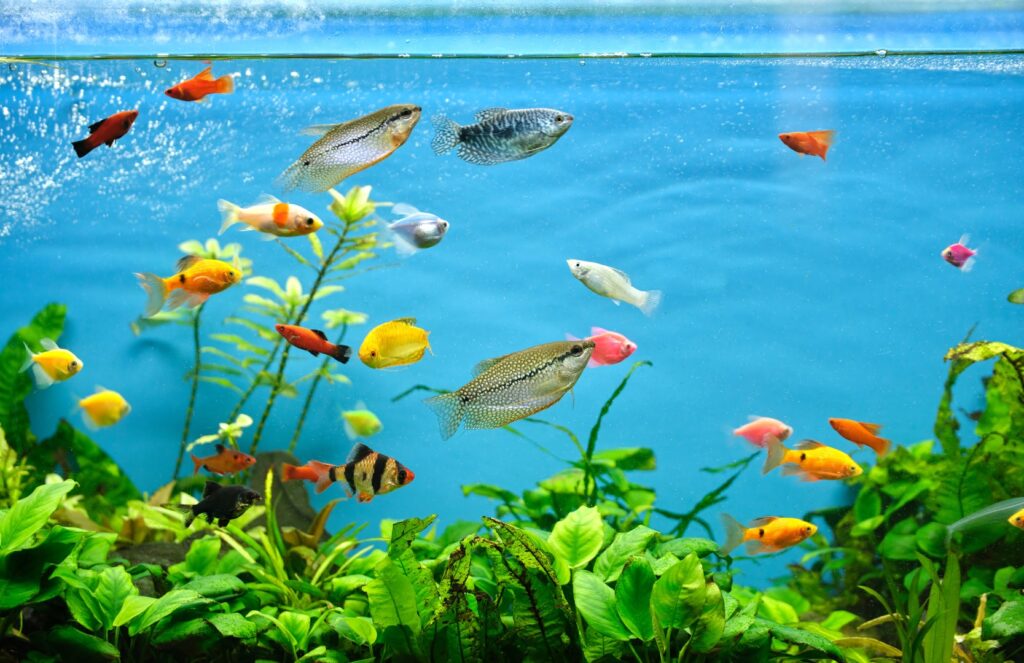
Table of Contents
Neon Tetra
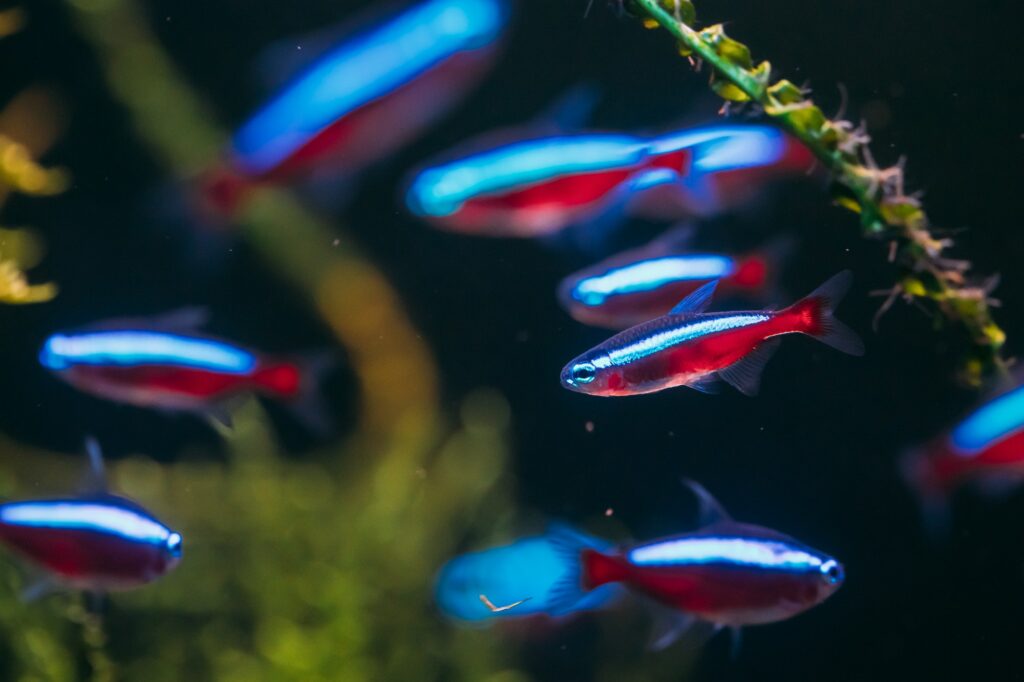
| Common/Market Names | Price Range | Care Level | Market Availability |
|---|---|---|---|
| Neon Tetra | $1-$3 | Easy | Very Common |
Neon Tetras are known for their striking blue and red coloration. Their bodies feature a bright neon blue stripe running from nose to tail, with a vibrant red stripe on the lower half of their body. Originally from the blackwater streams of the Amazon basin in South America, these fish were first discovered in 1934 and quickly became popular in the aquarium trade. Their small size and dazzling colors make them a favorite among aquarists worldwide.
Corydoras Catfish
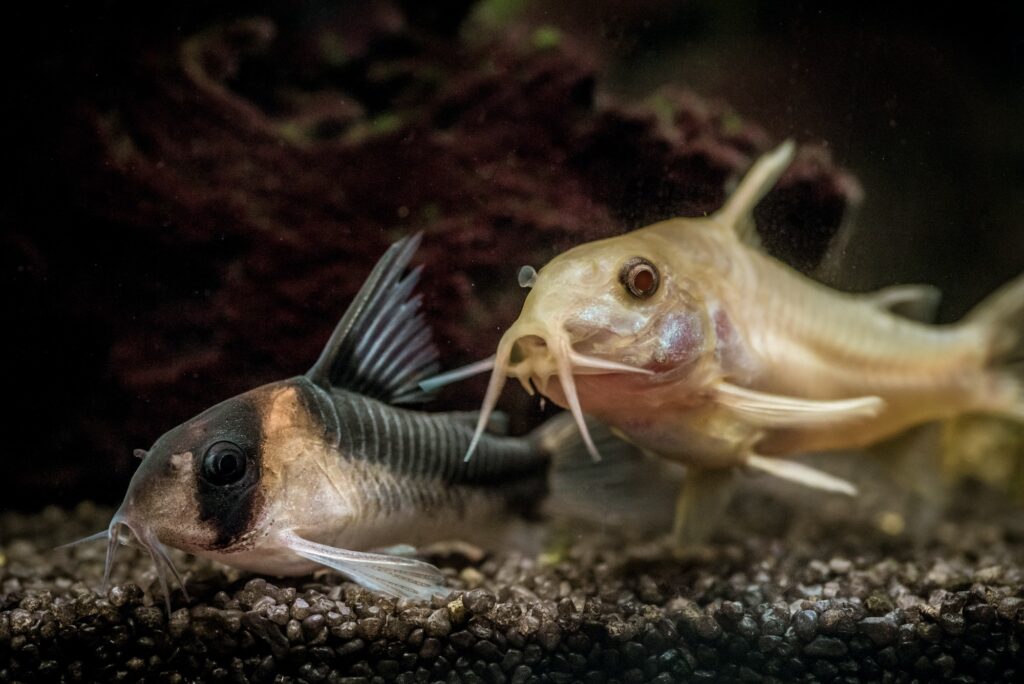
| Common/Market Names | Price Range | Care Level | Market Availability |
|---|---|---|---|
| Cory Cat, Armored Catfish | $3-$10 | Easy | Common |
Corydoras catfish come in various color patterns, often featuring combinations of bronze, black, white, and gold. These armored catfish originate from South America, inhabiting slow-moving rivers and streams. First described scientifically in 1803, Corydoras have been popular in the aquarium hobby for decades due to their peaceful nature and interesting bottom-dwelling behavior. There are over 160 described species, with new ones still being discovered.
Platy
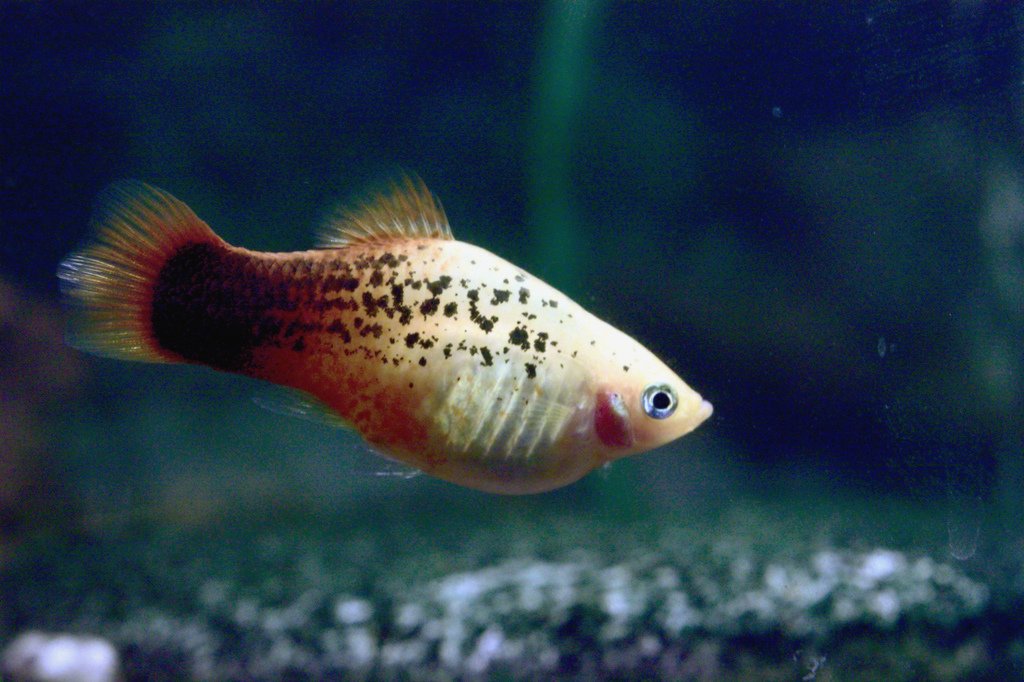
| Common/Market Names | Price Range | Care Level | Market Availability |
|---|---|---|---|
| Platy, Moonfish | $2-$5 | Easy | Very Common |
Platies are available in a wide array of colors, including red, orange, yellow, blue, and various patterns like Mickey Mouse and tuxedo. Native to Central America, particularly southern Mexico and northern Central America, platies were first introduced to the aquarium trade in the early 20th century. Through selective breeding, aquarists have developed numerous color varieties, making them one of the most popular livebearers in the hobby.
Cherry Barb
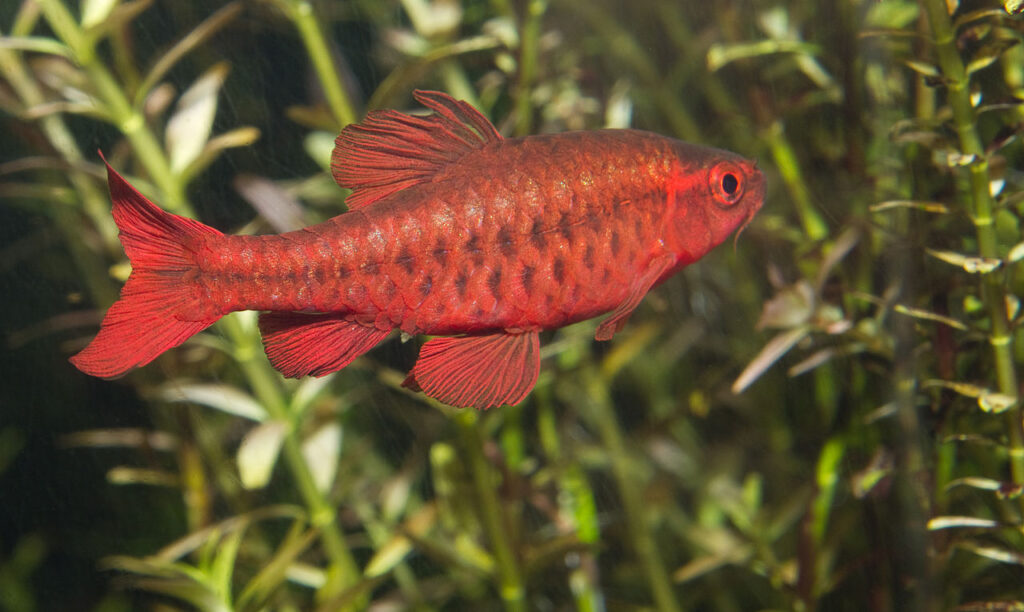
| Common/Market Names | Price Range | Care Level | Market Availability |
|---|---|---|---|
| Cherry Barb | $2-$4 | Easy | Common |
Cherry Barbs are known for their vibrant red coloration, especially in males during breeding. Females are typically paler with a golden-brown hue. Native to Sri Lanka, these fish were first described in 1868. They gained popularity in the aquarium trade due to their peaceful nature and striking appearance. Cherry Barbs have become important in conservation efforts as their natural habitats face threats from development and pollution.
Dwarf Gourami
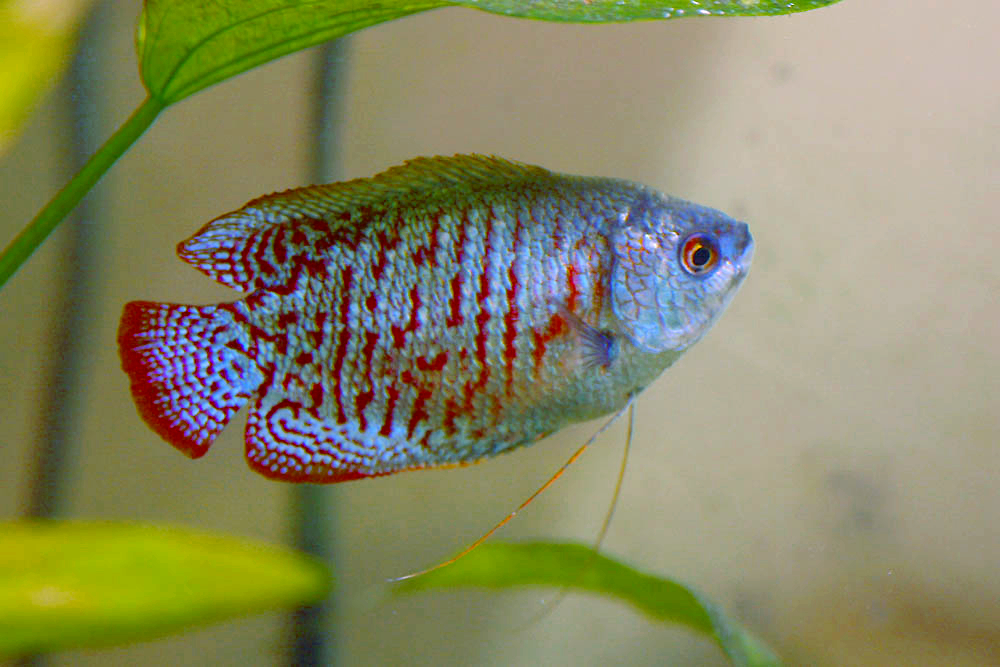
| Common/Market Names | Price Range | Care Level | Market Availability |
|---|---|---|---|
| Dwarf Gourami, Powder Blue Gourami | $4-$8 | Moderate | Common |
Dwarf Gouramis display a beautiful array of colors, with males showing vibrant blue or red bodies adorned with orange or red vertical stripes. Females are typically silvery-blue. Originally from India and Bangladesh, these fish were introduced to the aquarium trade in the 1950s. They quickly became popular due to their small size and striking colors. Selective breeding has resulted in various color morphs, including the popular powder blue and flame variants.
Harlequin Rasbora
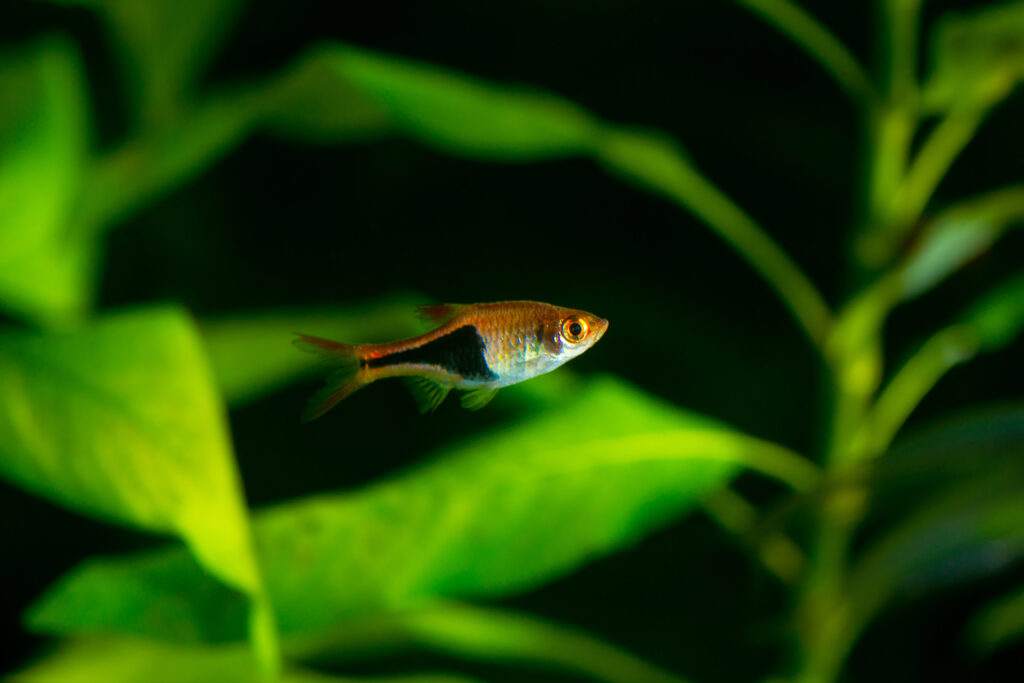
| Common/Market Names | Price Range | Care Level | Market Availability |
|---|---|---|---|
| Harlequin Rasbora, Red Rasbora | $2-$4 | Easy | Common |
Harlequin Rasboras are known for their distinctive coloration – a copper-orange body with a large black triangle covering the rear half of their body. Native to Thailand, Malaysia, and Indonesia, these fish were first described in 1904. They became popular in the aquarium trade in the 1920s and have remained a favorite due to their peaceful nature and unique appearance. Their natural habitats include slow-moving, tannin-stained forest streams.
Celestial Pearl Danio
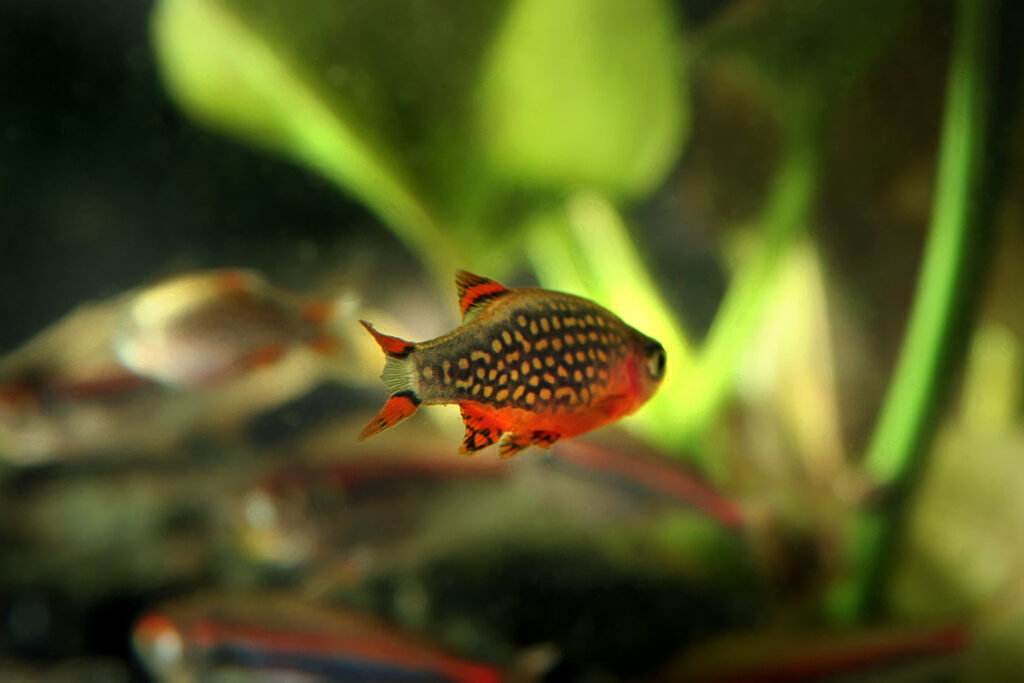
| Common/Market Names | Price Range | Care Level | Market Availability |
|---|---|---|---|
| Galaxy Rasbora, Celestial Pearl Danio | $5-$10 | Moderate | Uncommon |
Celestial Pearl Danios have a dark blue body covered in small, pearl-like white spots, with bright red fins. This species was only discovered in 2006 in Myanmar (Burma) and quickly became highly sought after in the aquarium trade due to its stunning appearance. Initially known as Galaxy Rasboras, they were later reclassified as danios. Their popularity led to concerns about overfishing, prompting efforts to establish captive breeding programs to reduce pressure on wild populations.
Bristlenose Pleco
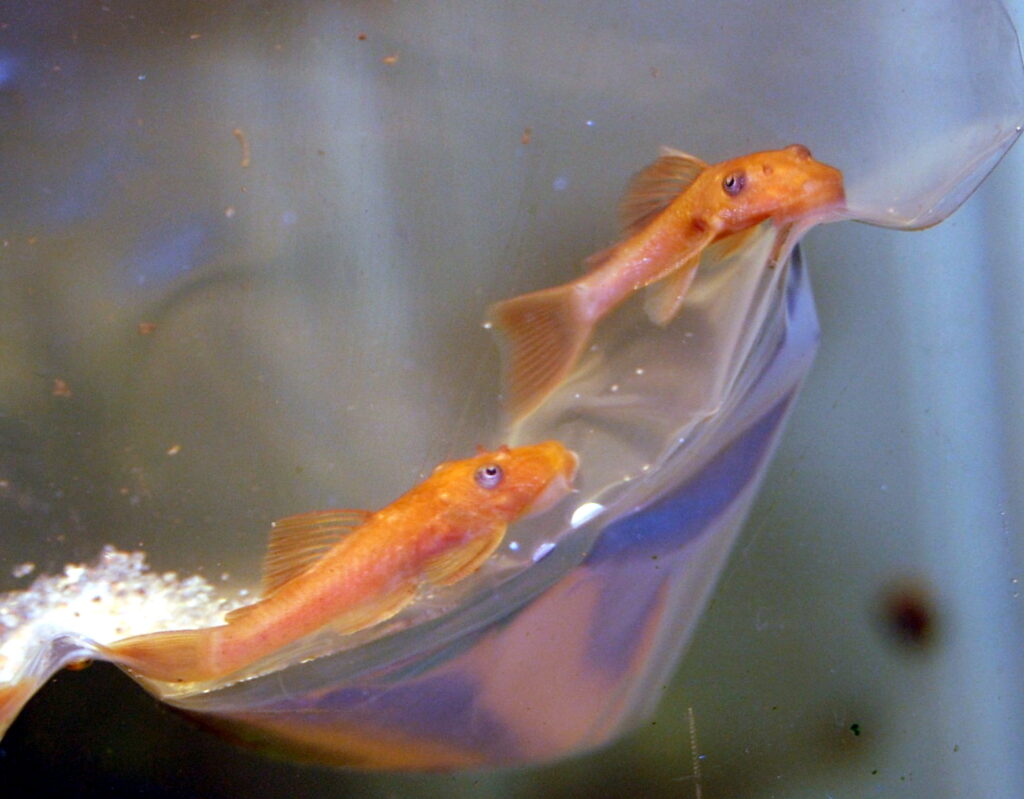
| Common/Market Names | Price Range | Care Level | Market Availability |
|---|---|---|---|
| Bushynose Pleco, Bristlenose Catfish | $5-$15 | Easy | Common |
Bristlenose Plecos are typically brown or gray with light spots or patterns. They’re known for the bristle-like growths on their snouts, which are more prominent in males. Native to South America, particularly the Amazon River basin, these fish were introduced to the aquarium trade in the mid-20th century. They quickly gained popularity as an alternative to the larger common pleco, due to their smaller size and efficient algae-eating habits. Various color morphs, including albino and long-fin varieties, have been developed through selective breeding.
Otocinclus Catfish
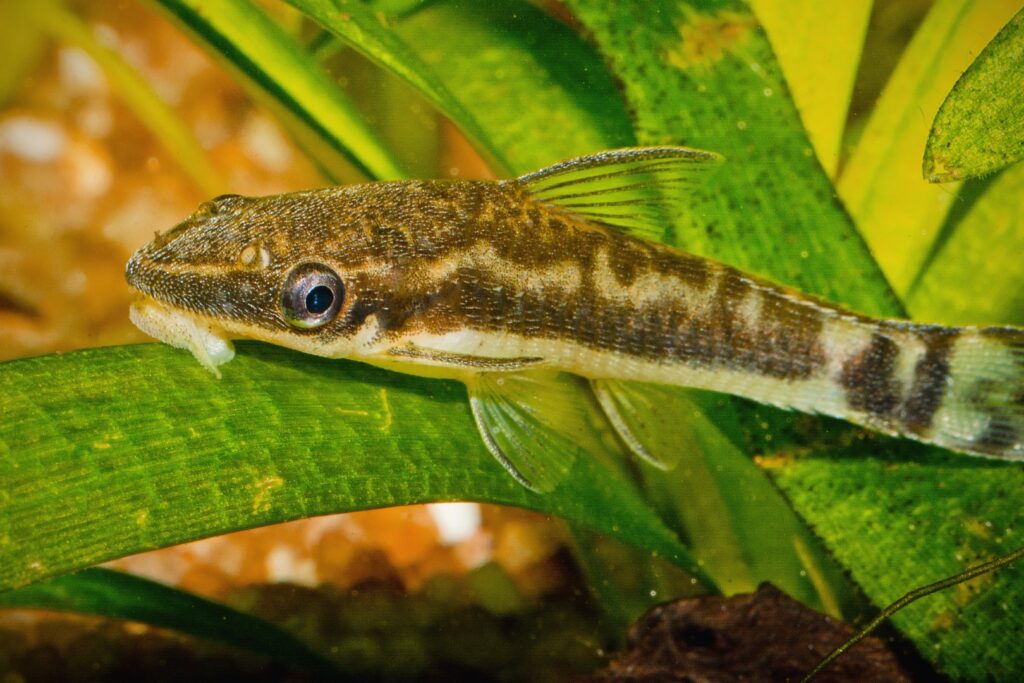
| Common/Market Names | Price Range | Care Level | Market Availability |
|---|---|---|---|
| Oto Cat, Dwarf Sucker | $2-$5 | Moderate | Common |
Otocinclus catfish are small, slender fish with a mottled brown and black pattern that provides excellent camouflage. They originate from various river systems in South America, including the Amazon. First described scientifically in 1836, they became popular in the aquarium trade in the late 20th century as effective algae eaters for smaller tanks. Their small size and peaceful nature make them ideal for community aquariums, though they can be sensitive to poor water conditions.
Kuhli Loach
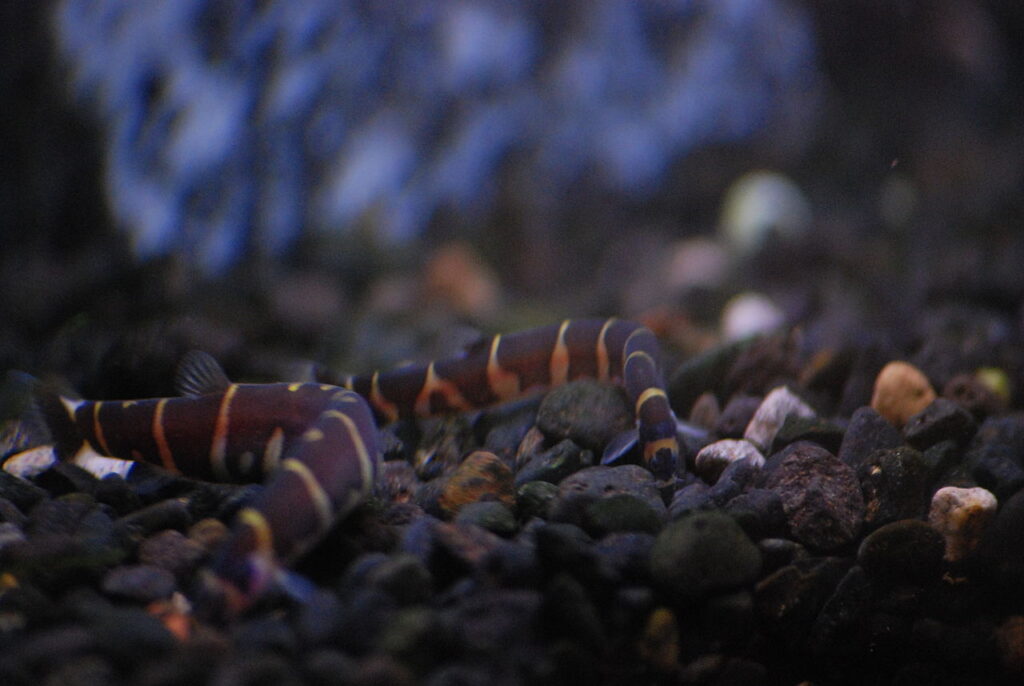
| Common/Market Names | Price Range | Care Level | Market Availability |
|---|---|---|---|
| Coolie Loach, Leopard Loach | $3-$6 | Easy | Common |
Kuhli Loaches have a distinctive eel-like body with a pattern of dark brown bands circling a pink or yellow base color. Native to Southeast Asia, including Malaysia, Indonesia, and Thailand, these fish were first described in 1846. They became popular in the aquarium trade due to their unique appearance and behavior. Kuhli Loaches are known for their nocturnal habits and tendency to hide, which adds an element of intrigue to aquariums. They prefer to live in groups and are often more active when kept with their own kind.
Guppy
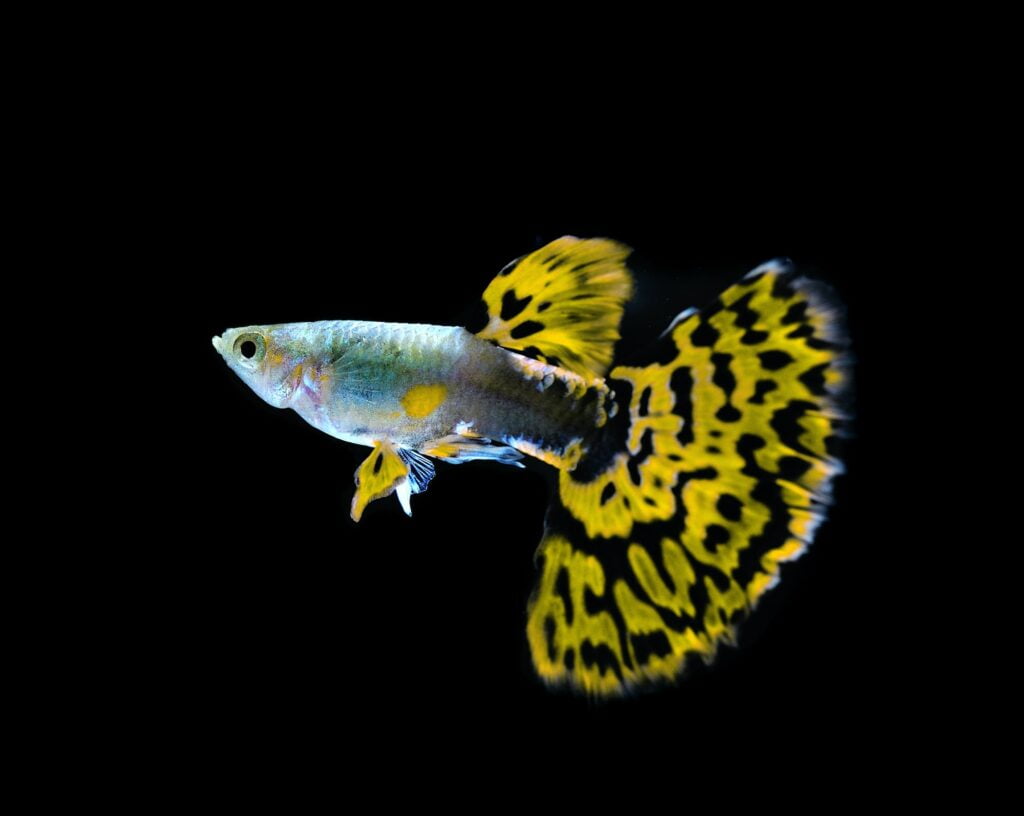
| Common/Market Names | Price Range | Care Level | Market Availability |
|---|---|---|---|
| Fancy Guppy, Million Fish | $1-$5 | Easy | Very Common |
Guppies are renowned for their incredible variety of colors and tail shapes, thanks to extensive selective breeding. In the wild, they typically have a more subdued olive-gray coloration. Originally from northeast South America, guppies were first described in 1866 and quickly spread worldwide, both as aquarium fish and for mosquito control. Their prolific breeding habits earned them the nickname “million fish.” Guppies have been the subject of numerous scientific studies and have played a significant role in the development of the modern aquarium hobby.
Mollies
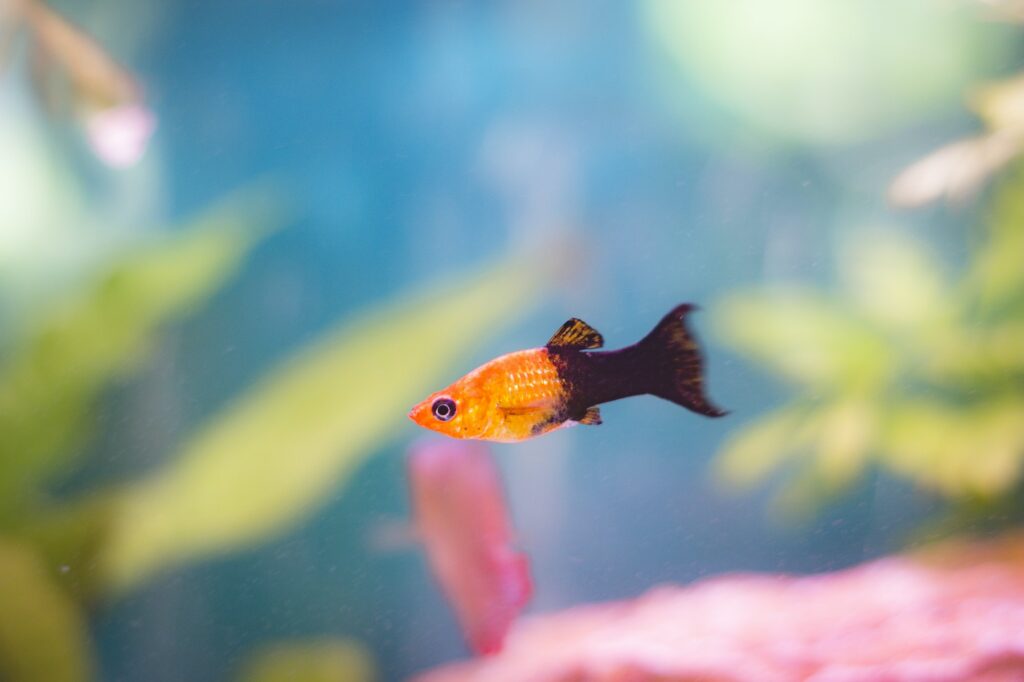
| Common/Market Names | Price Range | Care Level | Market Availability |
|---|---|---|---|
| Sailfin Molly, Black Molly | $2-$5 | Easy | Very Common |
Mollies come in a wide range of colors, including black, white, orange, and dalmatian patterns. The sailfin variety has an enlarged dorsal fin. Native to freshwater and brackish environments in the Americas, from Mexico to Colombia, mollies were first introduced to the aquarium trade in the early 20th century. They’ve since become one of the most popular livebearers due to their hardiness and variety. Mollies have been selectively bred to produce numerous color morphs and fin variations, making them a staple in the aquarium hobby.
Zebra Danio
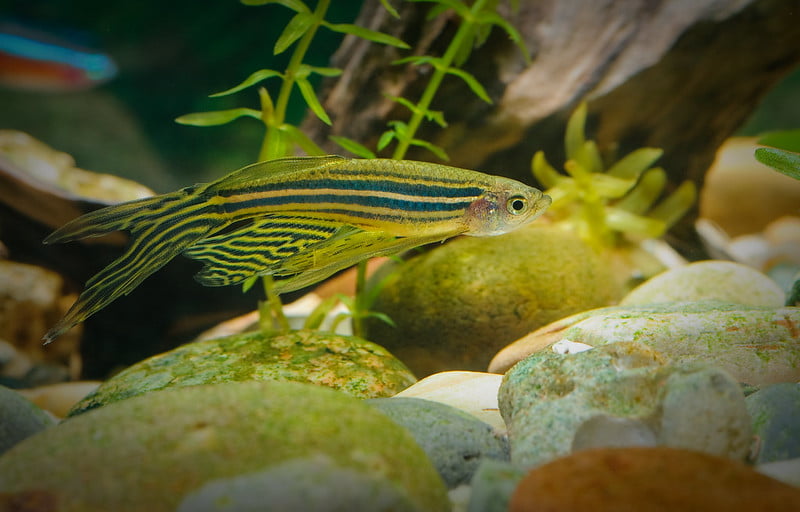
| Common/Market Names | Price Range | Care Level | Market Availability |
|---|---|---|---|
| Zebrafish, Stripey | $1-$3 | Easy | Very Common |
Zebra Danios have a distinctive pattern of horizontal blue stripes on a silver body. Native to the Ganges region in eastern India, Nepal, and Bangladesh, they were first described scientifically in 1822. Zebra Danios became popular in the aquarium trade due to their hardy nature and active behavior. In recent decades, they’ve gained significance as an important model organism in scientific research, particularly in developmental biology and genetics. Various color morphs have been developed, including the popular GloFish varieties.
Ember Tetra
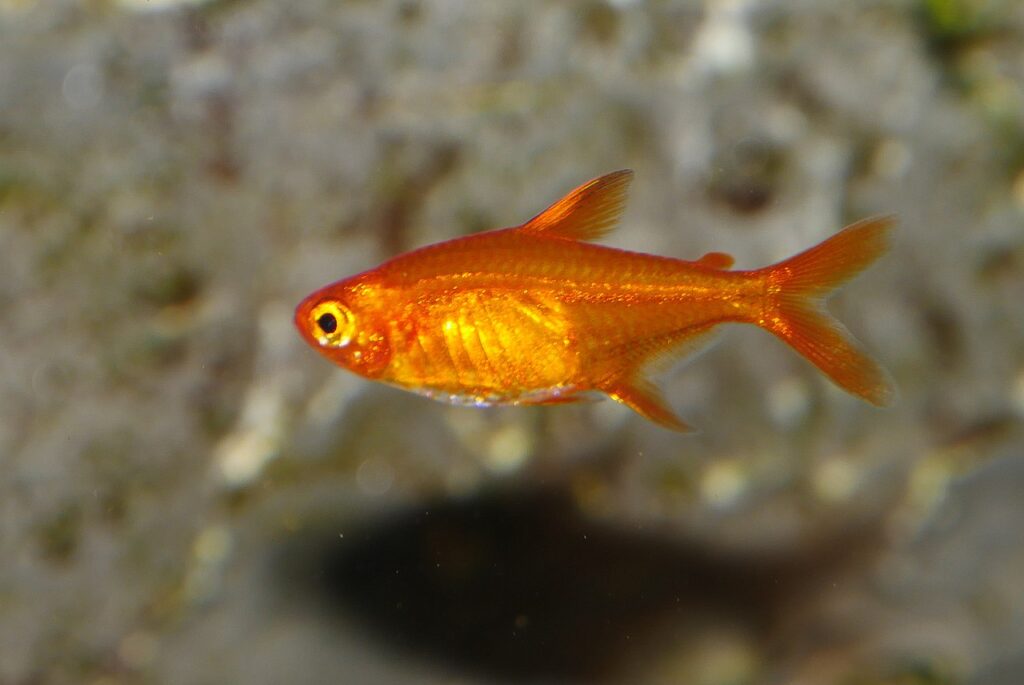
| Common/Market Names | Price Range | Care Level | Market Availability |
|---|---|---|---|
| Ember Tetra, Fire Tetra | $2-$4 | Easy | Common |
Ember Tetras are known for their vibrant orange-red coloration, which gives them their fiery name. These tiny fish are native to the Araguaia River basin in central Brazil and were first discovered in the 1980s. They were introduced to the aquarium trade in the early 2000s and quickly gained popularity due to their striking color and peaceful nature. Ember Tetras are often chosen for nano aquariums and planted tanks, where their bright colors contrast beautifully with green plants.
Pearl Gourami
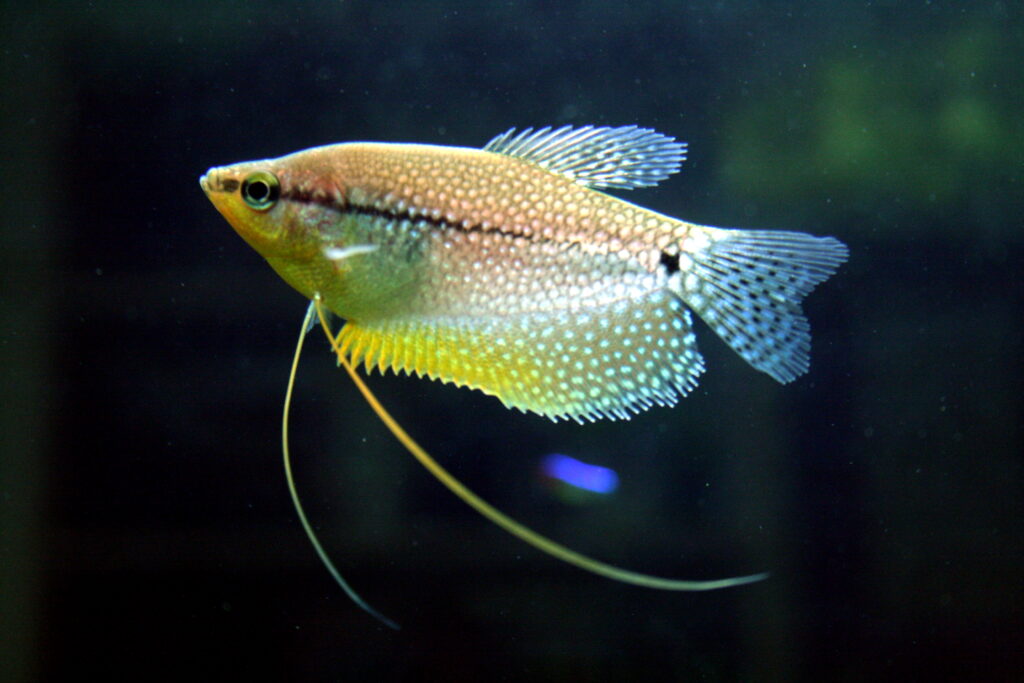
| Common/Market Names | Price Range | Care Level | Market Availability |
|---|---|---|---|
| Lace Gourami, Mosaic Gourami | $5-$10 | Moderate | Common |
Pearl Gouramis have a silvery-gray body covered in a pattern of small pearl-like spots, with males developing orange-red coloration on their throat and fins. Native to Southeast Asia, including Thailand, Malaysia, and Indonesia, they were first described in 1831. Pearl Gouramis became popular in the aquarium trade due to their peaceful nature and elegant appearance. They are known for their labyrinth organ, which allows them to breathe air directly, an adaptation to their natural habitat of slow-moving, oxygen-poor waters.
Rummy Nose Tetra
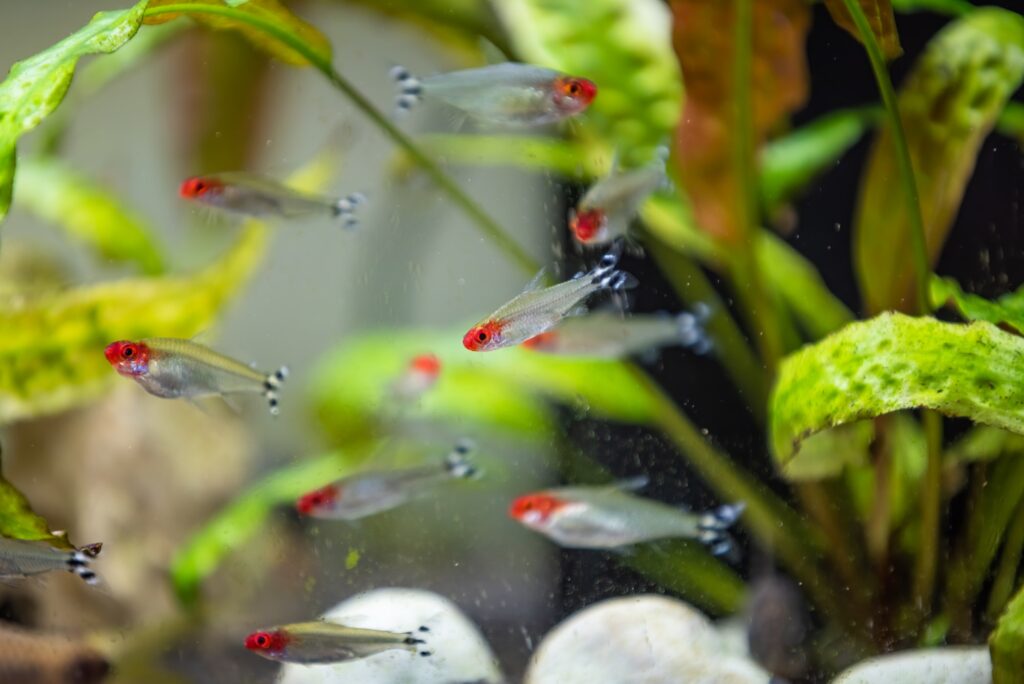
| Common/Market Names | Price Range | Care Level | Market Availability |
|---|---|---|---|
| Rummy Nose, Firehead Tetra | $2-$4 | Moderate | Common |
Rummy Nose Tetras are known for their distinctive bright red heads, which contrast sharply with their silver bodies and black-and-white striped tails. Native to the Amazon basin in South America, they were first described in 1924. These fish gained popularity in the aquarium trade due to their striking appearance and schooling behavior. Interestingly, the intensity of their red “nose” is often used as an indicator of water quality by experienced aquarists, as it tends to fade in poor conditions.
Black Skirt Tetra
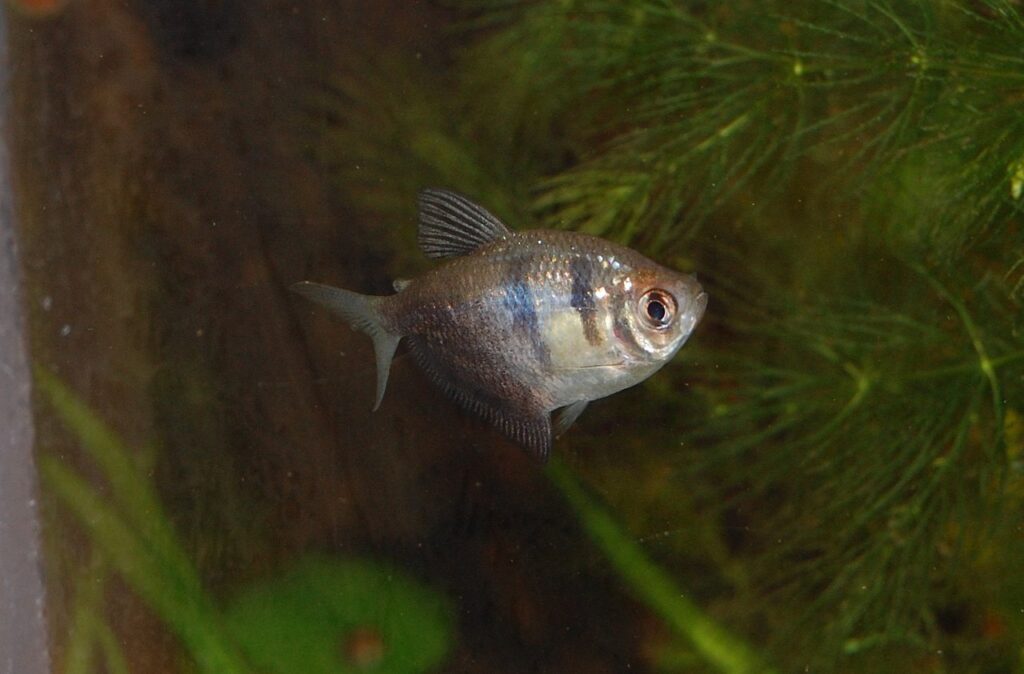
| Common/Market Names | Price Range | Care Level | Market Availability |
|---|---|---|---|
| Black Widow Tetra, Petticoat Tetra | $2-$4 | Easy | Common |
Black Skirt Tetras have a silvery-gray body with distinctive black markings on their fins, giving them a “skirted” appearance. Originally from the Paraguay and Guaporé river basins in South America, they were introduced to the aquarium trade in the 1950s. Their hardiness and unique appearance quickly made them popular among hobbyists. Selective breeding has resulted in long-finned varieties and albino forms. Despite their sometimes nippy behavior, they remain a favorite choice for community tanks.
Serpae Tetra
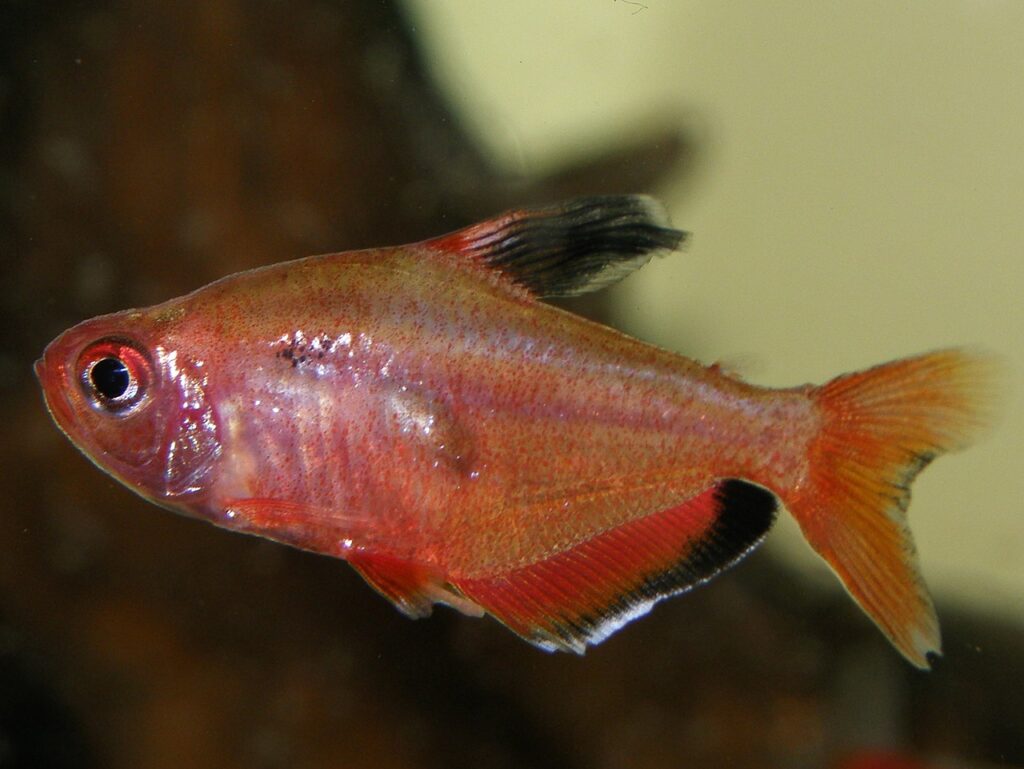
| Common/Market Names | Price Range | Care Level | Market Availability |
|---|---|---|---|
| Red Minor Tetra, Jewel Tetra | $2-$4 | Easy | Common |
Serpae Tetras are known for their deep red coloration and a distinctive black spot behind their gills. Native to the Guaporé and Paraguay river basins in South America, they were first described in 1858. These fish became popular in the aquarium trade due to their vibrant color and active nature. While they can be slightly nippy, especially in small groups, they are generally considered good community fish when kept in proper schools. Their bright color makes them stand out in planted aquariums.
Bolivian Ram
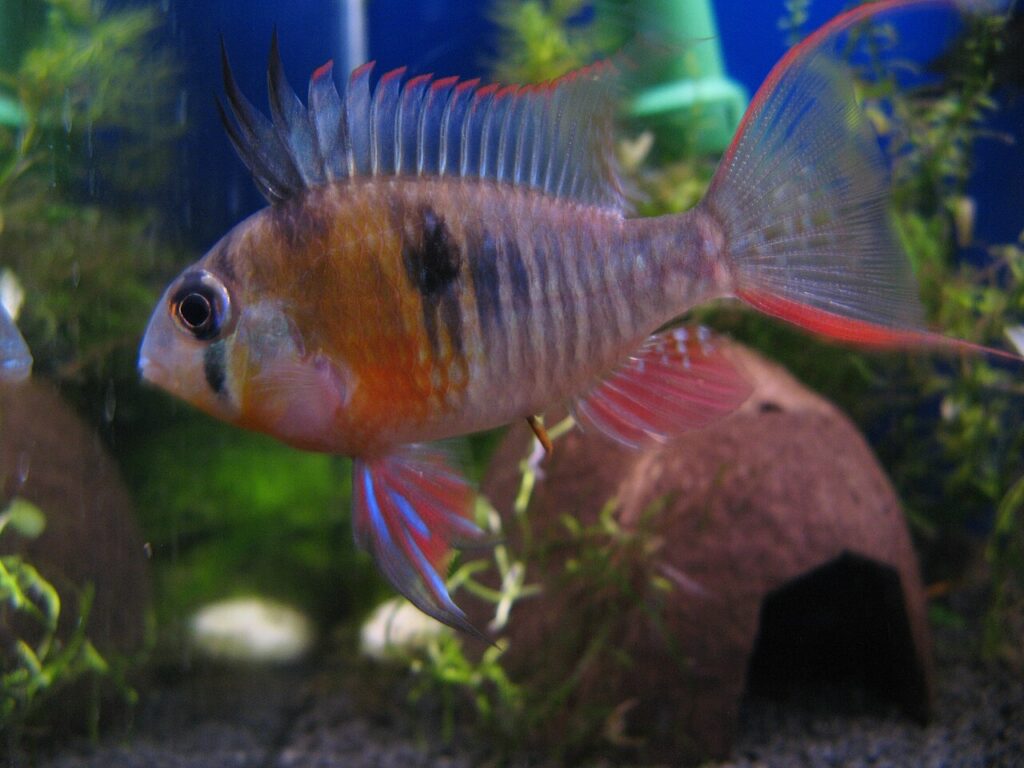
| Common/Market Names | Price Range | Care Level | Market Availability |
|---|---|---|---|
| Ruby Cichlid, Red-Finned Butterfly Cichlid | $5-$10 | Moderate | Common |
Bolivian Rams have a subtle beauty with their tan bodies adorned with blue, red, and black markings. As their name suggests, they are native to Bolivia, specifically the Amazon and Río Mamoré basins. First described in 1906, they became popular in the aquarium trade as a peaceful alternative to the more aggressive cichlids. Bolivian Rams are known for their interesting behavior, including their careful parental care of their young. They are often chosen for South American biotope aquariums.
Honey Gourami
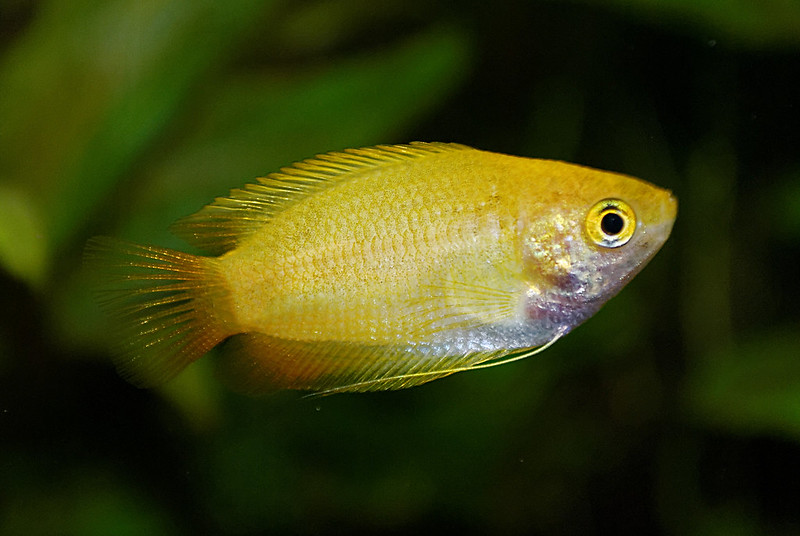
| Common/Market Names | Price Range | Care Level | Market Availability |
|---|---|---|---|
| Sunset Honey Gourami, Red Honey Gourami | $4-$8 | Easy | Common |
Honey Gouramis are known for their warm, honey-golden coloration, with males developing intense orange-red hues when breeding. Native to Bangladesh, India, and Nepal, they were first described in 1877. These fish gained popularity in the aquarium trade due to their peaceful nature and smaller size compared to other gouramis. Like other gouramis, they possess a labyrinth organ allowing them to breathe air, an adaptation to their natural habitat of slow-moving, oxygen-poor waters. Various color morphs have been developed, including the vibrant “sunset” variety.
Phantom Tetra
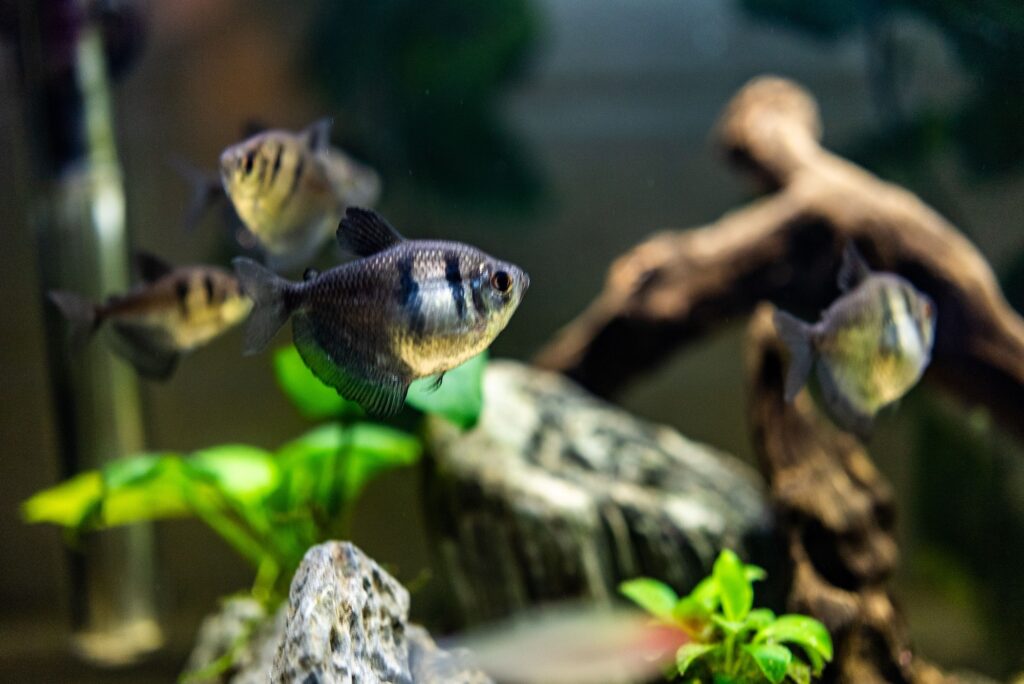
| Common/Market Names | Price Range | Care Level | Market Availability |
|---|---|---|---|
| Black Phantom Tetra, Red-Eyed Tetra | $2-$4 | Easy | Common |
Phantom Tetras have a translucent silvery-gray body with a distinctive black vertical band and red eyes. Males develop darker fins and a more intense black coloration. Native to the Paraguay and Guaporé river basins in South America, they were first described in 1915. These fish became popular in the aquarium trade due to their unique appearance and peaceful nature. They are often chosen for community tanks and planted aquariums, where their subtle coloration provides an interesting contrast to more vibrant fish species.
Glass Catfish
| Common/Market Names | Price Range | Care Level | Market Availability |
|---|---|---|---|
| Ghost Catfish, Indian Glass Catfish | $5-$10 | Moderate | Uncommon |
Glass Catfish are known for their transparent bodies, which allow you to see their internal organs and skeleton. Native to Thailand and surrounding areas in Southeast Asia, they were first described in 1854. These unique fish gained popularity in the aquarium trade due to their fascinating transparent appearance. They prefer to live in groups and are often more active and visible when kept in schools. Glass Catfish add an element of intrigue to aquariums, and their unusual appearance makes them a great conversation starter.
Endler’s Livebearer
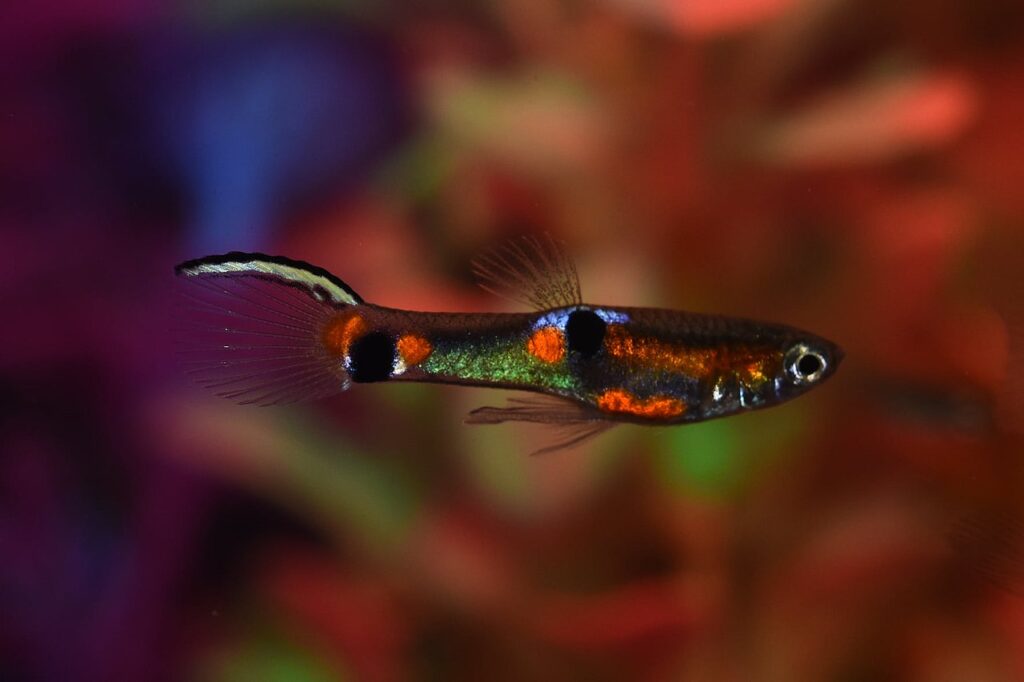
| Common/Market Names | Price Range | Care Level | Market Availability |
|---|---|---|---|
| Endler’s Guppy, Campoma Guppy | $3-$6 | Easy | Common |
Endler’s Livebearers are known for their vibrant colors, typically featuring combinations of orange, green, and black in intricate patterns. Native to Venezuela, specifically Laguna de Patos, they were discovered in 1937 by Franklyn F. Bond but only described scientifically in 2005. These fish gained popularity in the aquarium trade due to their small size, vivid colors, and energetic behavior. They are closely related to guppies and can interbreed, leading to ongoing debates about their species status. Endler’s are popular in nano aquariums and planted tanks.
Panda Cory
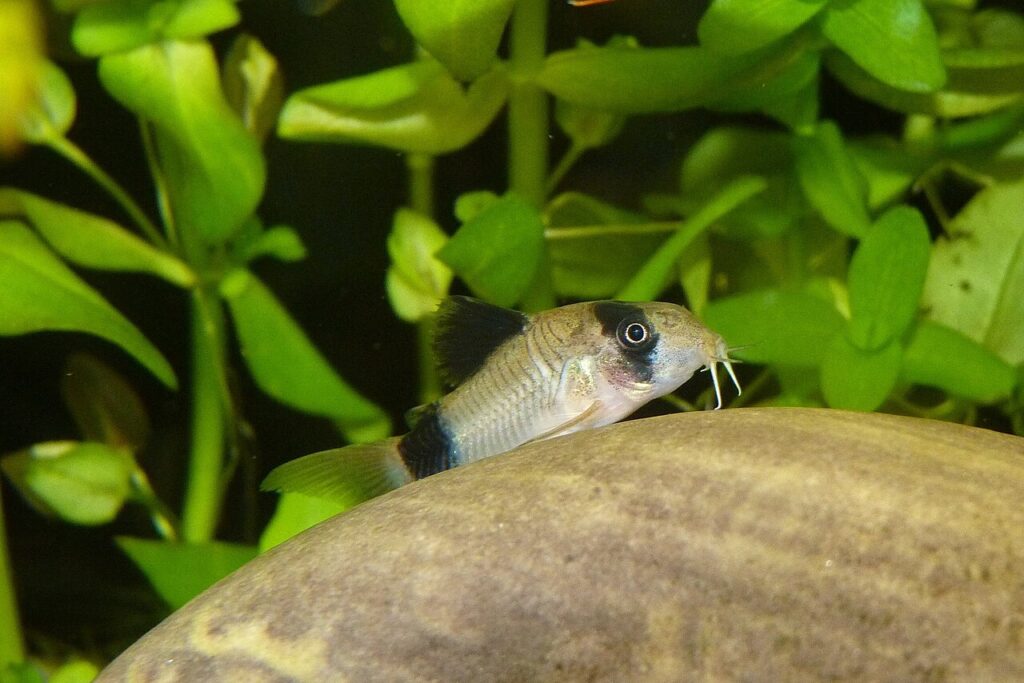
| Common/Market Names | Price Range | Care Level | Market Availability |
|---|---|---|---|
| Panda Corydoras, Panda Cory Cat | $3-$6 | Easy | Common |
Panda Corydoras are known for their distinctive black and white coloration, resembling a miniature panda bear. Native to the Río Pachitea basin in Peru, they were first described in 1971. These charming catfish quickly became popular in the aquarium trade due to their cute appearance and peaceful nature. Like other Corydoras species, they are bottom-dwellers and excellent scavengers, helping to keep the aquarium clean. Panda Corys are social fish and are best kept in groups, where they display interesting behaviors and interactions.
Pristella Tetra
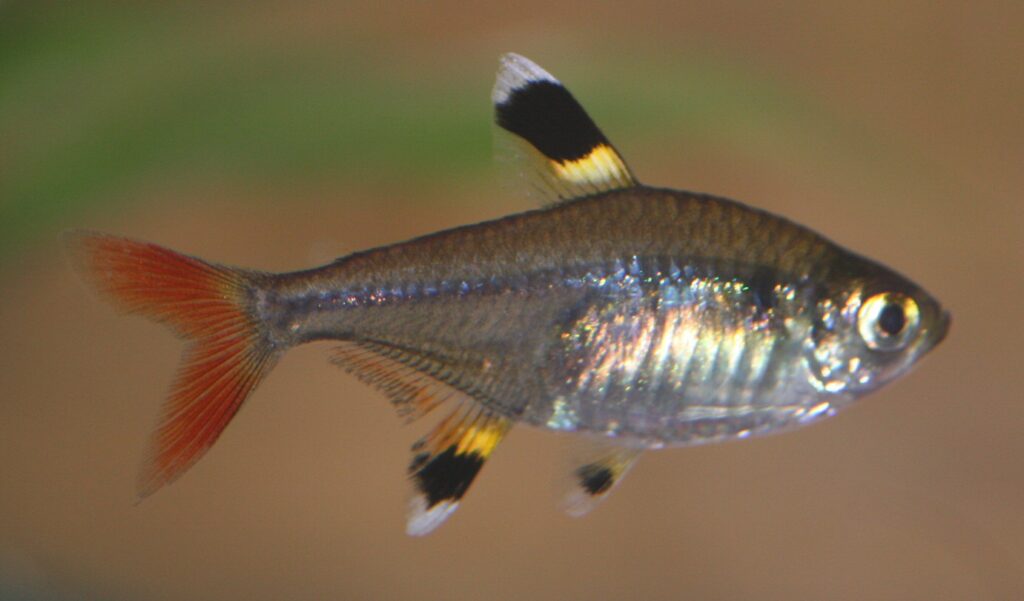
| Common/Market Names | Price Range | Care Level | Market Availability |
|---|---|---|---|
| X-Ray Tetra, Golden Pristella Tetra | $2-$4 | Easy | Common |
Pristella Tetras have a translucent body with yellow, black, and white fin markings, earning them the nickname “X-Ray Tetra”. Native to the coastal regions of northeastern South America, including Guyana and Brazil, they were first described in 1908. These fish became popular in the aquarium trade due to their hardiness and unique appearance. Pristella Tetras are known for their peaceful nature and their ability to adapt to a wide range of water conditions, making them an excellent choice for beginners and experienced aquarists alike.
Lambchop Rasbora
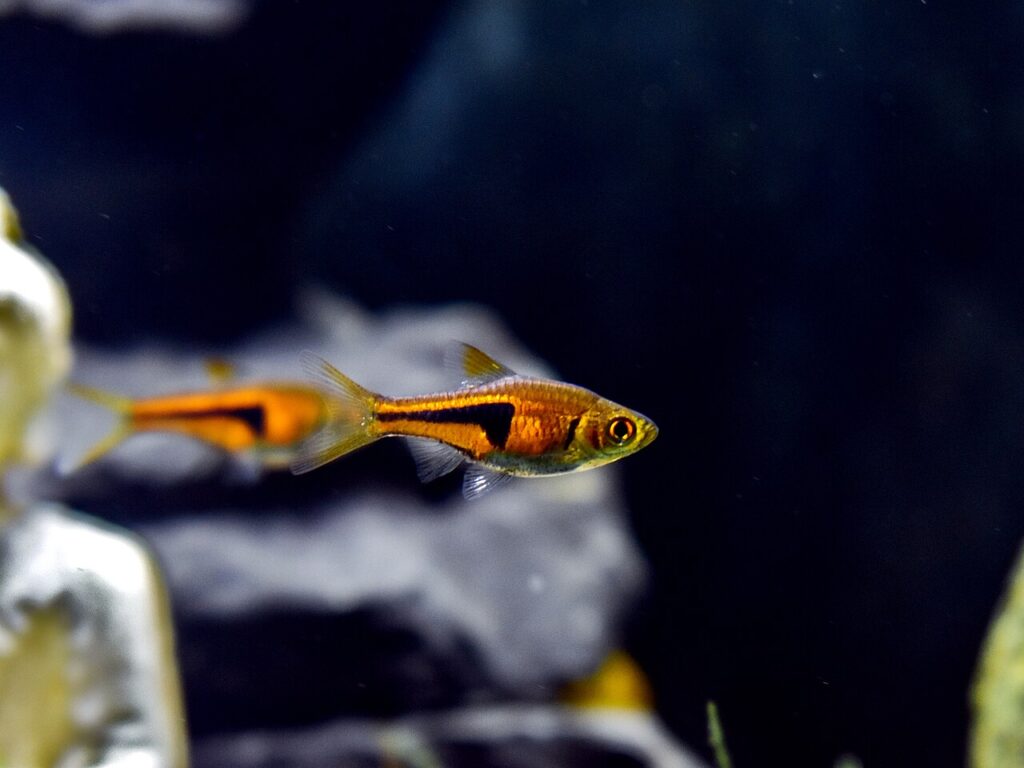
| Common/Market Names | Price Range | Care Level | Market Availability |
|---|---|---|---|
| Lambchop Rasbora, Hengel’s Rasbora | $2-$4 | Easy | Common |
Lambchop Rasboras are known for their distinctive black wedge-shaped marking on their sides, resembling a lamb chop. Their body is typically a golden or bronze color. Native to Southeast Asia, including Thailand and Malaysia, they were first described in 1904. These fish gained popularity in the aquarium trade due to their peaceful nature and interesting coloration. Lambchop Rasboras are often chosen for planted aquariums and nano tanks, where their subtle beauty and schooling behavior can be fully appreciated.
Bloodfin Tetra
| Common/Market Names | Price Range | Care Level | Market Availability |
|---|---|---|---|
| Argentine Bloodfin, Red-Finned Tetra | $2-$4 | Easy | Common |
Bloodfin Tetras have a silver body with bright red fins, giving them their distinctive name. Native to the Paraná River basin in South America, including parts of Brazil, Paraguay, and Argentina, they were first described in 1907. These fish became popular in the aquarium trade due to their hardiness and striking appearance. Bloodfin Tetras are known for their active, schooling behavior and are often recommended for beginners due to their adaptability to various water conditions. They add a flash of color and movement to community tanks.
Dwarf Rainbowfish
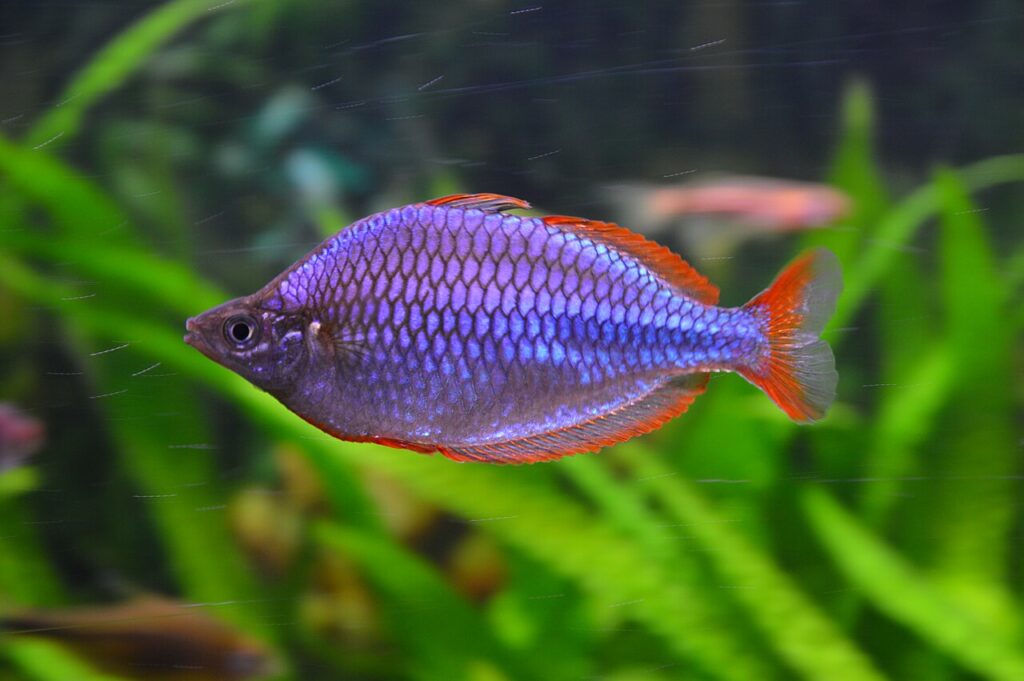
| Common/Market Names | Price Range | Care Level | Market Availability |
|---|---|---|---|
| Neon Rainbowfish, Praecox Rainbow | $5-$10 | Moderate | Common |
Dwarf Rainbowfish are known for their iridescent blue bodies and red fins, which become more vibrant in males. Native to the Mamberamo River system in West Papua, Indonesia, they were first described in 1922. These fish gained popularity in the aquarium trade due to their smaller size compared to other rainbowfish species and their striking coloration. Dwarf Rainbowfish are peaceful schooling fish that display interesting behaviors when kept in groups. Their colors become more intense under good lighting conditions, making them a favorite for well-planted aquariums.
Pygmy Corydoras
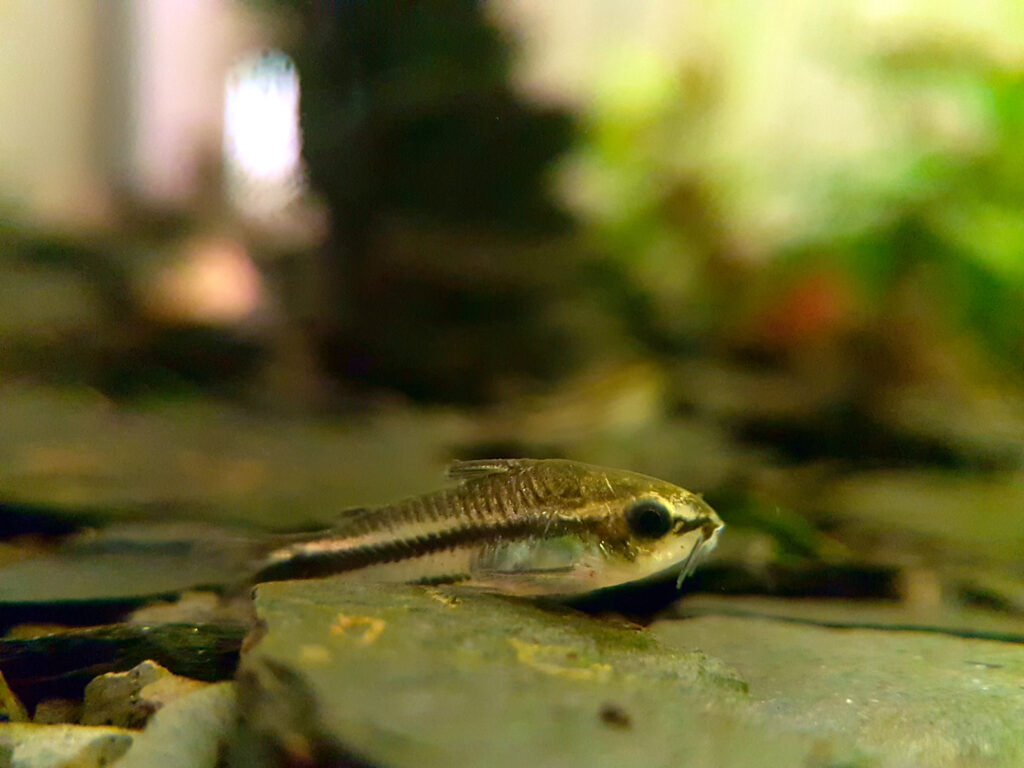
| Common/Market Names | Price Range | Care Level | Market Availability |
|---|---|---|---|
| Pygmy Cory, Dwarf Corydoras | $3-$5 | Easy | Uncommon |
Pygmy Corydoras are tiny catfish with a light brown body and a dark stripe running along their side. Native to the Amazon River basin in South America, they were first described in 1966. These diminutive fish became popular in the aquarium trade due to their small size, which makes them suitable for nano aquariums. Unlike many other Corydoras species that are primarily bottom-dwellers, Pygmy Corys often swim in the middle water column, exhibiting more active and social behavior. They are best kept in groups where they display interesting schooling behaviors.
Lemon Tetra
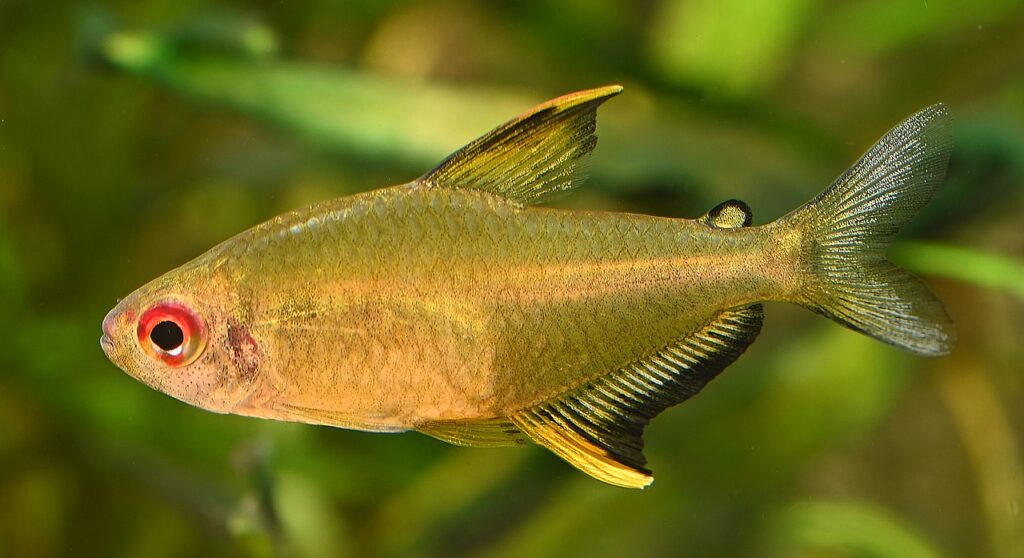
| Common/Market Names | Price Range | Care Level | Market Availability |
|---|---|---|---|
| Yellow Tetra, Golden Tetra | $2-$4 | Easy | Common |
Lemon Tetras have a translucent yellow body with hints of orange and red in their fins, particularly in males. Native to the Amazon River basin in Brazil, they were first described in 1915. These fish gained popularity in the aquarium trade due to their peaceful nature and the subtle, warm glow they add to aquariums. Lemon Tetras are often chosen for planted tanks, where their soft coloration complements the green of aquatic plants beautifully. They are schooling fish and display more vibrant colors and interesting behaviors when kept in groups.
The world of freshwater aquarium fish is a captivating microcosm of nature’s diversity, offering enthusiasts a chance to create vibrant underwater ecosystems in their own homes. From the neon-bright tetras to the graceful gouramis, each of the 30 species we’ve explored brings its own unique charm, color, and behavior to the aquarium. These fish, hailing from various corners of the globe, represent a spectrum of care levels and adaptations, making the hobby accessible to beginners and endlessly fascinating for seasoned aquarists alike.
Beyond their aesthetic appeal, these fish serve as ambassadors for their wild counterparts, raising awareness about aquatic ecosystems and conservation. The stories behind their discovery and introduction to the hobby remind us that aquarium keeping is a dynamic pursuit, constantly evolving with new findings and breeding successes. Whether you’re drawn to the subtle beauty of a schooling tetra or the personality of a dwarf cichlid, the world of freshwater aquarium fish offers endless opportunities for learning, appreciation, and the creation of thriving, harmonious underwater communities that bring the marvels of nature into our daily lives.